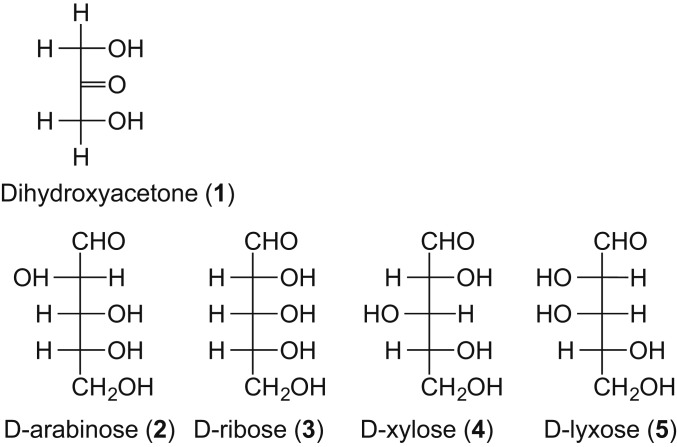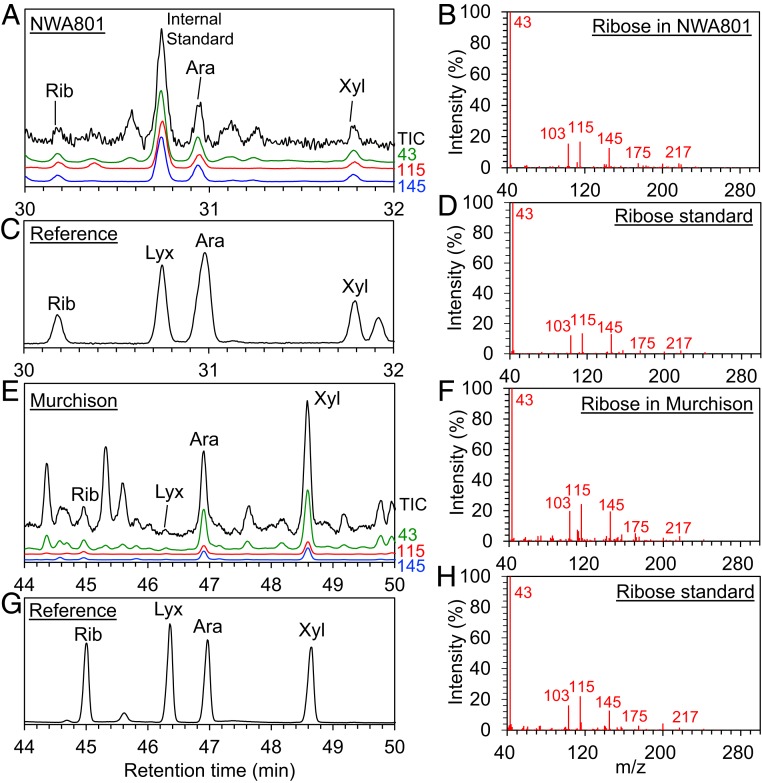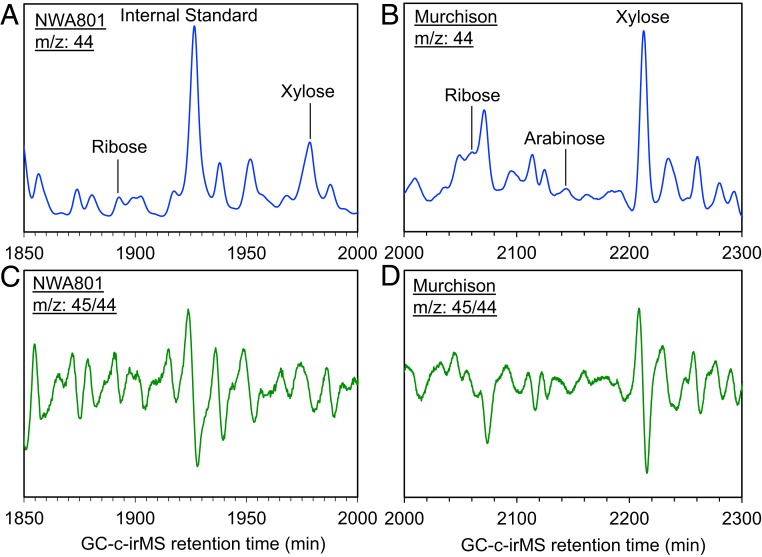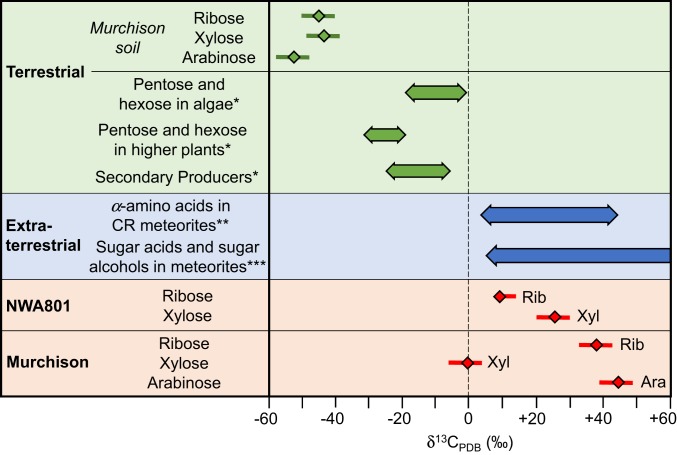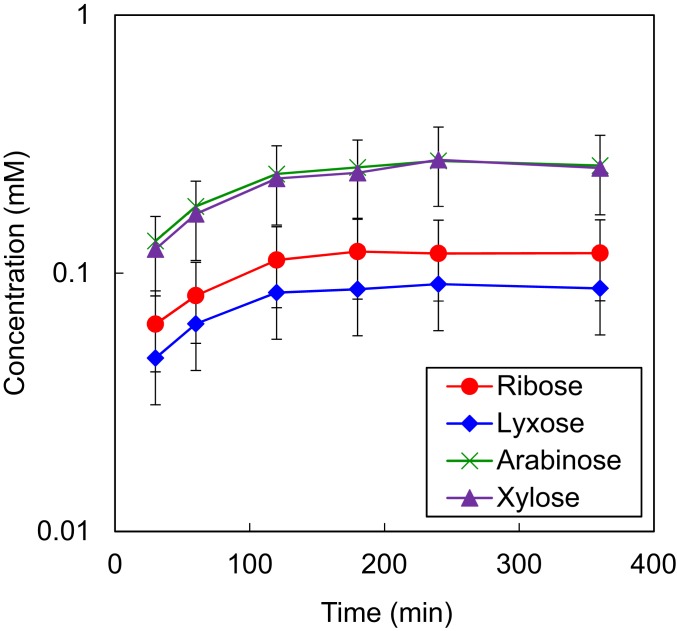Significance
Ribose is an essential sugar for present life as a building block of RNA, which could have both stored information and catalyzed reactions in primitive life on Earth. Meteorites contain a number of organic compounds including components of proteins and nucleic acids. Among the constituent molecular classes of proteins and nucleic acids (i.e., amino acids, nucleobases, phosphate, and ribose/deoxyribose), the presence of ribose and deoxyribose in space remains unclear. Here we provide evidence of extraterrestrial ribose and other bioessential sugars in primitive meteorites. Meteorites were carriers of prebiotic organic molecules to the early Earth; thus, the detection of extraterrestrial sugars in meteorites implies the possibility that extraterrestrial sugars may have contributed to forming functional biopolymers like RNA.
Keywords: meteorite, carbohydrate, exogenous delivery, ribose, RNA
Abstract
Sugars are essential molecules for all terrestrial biota working in many biological processes. Ribose is particularly essential as a building block of RNA, which could have both stored information and catalyzed reactions in primitive life on Earth. Meteorites contain a number of organic compounds including key building blocks of life, i.e., amino acids, nucleobases, and phosphate. An amino acid has also been identified in a cometary sample. However, the presence of extraterrestrial bioimportant sugars remains unclear. We analyzed sugars in 3 carbonaceous chondrites and show evidence of extraterrestrial ribose and other bioessential sugars in primitive meteorites. The 13C-enriched stable carbon isotope compositions (δ13C vs. VPDB) of the detected sugars show that the sugars are of extraterrestrial origin. We also conducted a laboratory simulation experiment of a potential sugar formation reaction in space. The compositions of pentoses in meteorites and the composition of the products of the laboratory simulation suggest that meteoritic sugars were formed by formose-like processes. The mineral compositions of these meteorites further suggest the formation of these sugars both before and after the accretion of their parent asteroids. Meteorites were carriers of prebiotic organic molecules to the early Earth; thus, the detection of extraterrestrial sugars in meteorites establishes the existence of natural geological routes to make and preserve them as well as raising the possibility that extraterrestrial sugars contributed to forming functional biopolymers like RNA on the early Earth or other primitive worlds.
Sugars are indispensable molecules for life, working along essential metabolic pathways and as constituents of sugar phosphate backbone of genetic molecules (DNA and RNA). Ribose is particularly essential as a building block of RNA, which could have both stored information and catalyzed reactions in primitive life on Earth (1, 2). Thus, the availability of abiotic sugars and their precursors on the prebiotic Earth has been investigated for many years (3–5).
Numerous studies have been conducted on meteoritic organic compounds, particularly amino acids and nucleobases (6–10). However, unlike these organic compounds, an extraterrestrial origin for biological sugars in meteorites has not yet been proven. In the 1960s, researchers reported the detection of common biological sugars, including arabinose 2, xylose 4, glucose, and mannose (Fig. 1), in both carbonaceous and ordinary chondrites in comparable concentrations (11, 12). As noted by the authors and the authors of a subsequent review, a major problem was the possibility of terrestrial contamination of the detected aldoses (13). Since the 2000s, Cooper and coworkers carefully analyzed carbonaceous meteorites by gas chromatography/mass spectrometry (GC/MS) and detected the simplest ketose, dihydroxyacetone 1, in the Murchison and Murray meteorites with several sugar alcohols and sugar acids; however, dihydroxyacetone has a lesser role in biology, the phosphate is used in central metabolism, but it has no known structural or informational roles (14). Cooper and Rios (15) verified that several sugar acids and sugar alcohols are extraterrestrial in origin, having stable carbon isotope ratios that differ substantially from terrestrial sugar alcohols and sugar acids. Therefore, to date, no previous research has verified the presence of extraterrestrial aldoses or other sugar compounds related to biological macromolecules in any astronomical sample (16).
Fig. 1.
Structures of sugars detected in this study (structures 2 to 5) and a previous study (structure 1) (shown in Fischer projection) from meteorites. All sugars are shown as d-form for simplicity; however, chirality was not investigated in this study.
We detected all 4 types of aldopentoses (i.e., ribose 3, arabinose, xylose, and lyxose 5) in concentrations of 2.3 to 11 ppb from NWA 801 and 6.7 to 180 ppb from the Murchison meteorite (Fig. 2; Table 1; and SI Appendix, Figs. S2 and S3). Several hexoses are also found in the NWA 801 and the Murchison meteorites. Conversely, in NWA 7020, these sugars were below our detection limit for the amount of sample analyzed (<0.5 ppb). Tetroses, sugar acids and sugar alcohols containing 5 carbon atoms (e.g., ribitol and ribonic acid), as well as 2-deoxyribose and branched isomers of aldopentoses, were below our detection limit in both meteorites (<0.5 ppb). We also analyzed serpentine which had been baked in air at 500 °C overnight as an analytical blank, and no pentoses were detected.
Fig. 2.
GC/MS identification of pentoses in meteorites and reference standards. (A) Total ion chromatogram and selected ion chromatograms of NWA 801 extract. (B) Mass fragment spectrum of ribose in NWA 801. (C) Total ion chromatogram and selected ion chromatograms of the reference standard mixture. (D) Mass fragment spectrum of ribose in the reference standard. (E) Total ion chromatogram and selected ion chromatograms of the Murchison extract. (F) Total ion chromatogram and selected ion chromatograms of the reference standard mixture. (G) Mass fragment spectrum of ribose in the Murchison. (H) Mass fragment spectrum of ribose in the reference standard.
Table 1.
Results of coordinated analysis of 3 meteorites
| NWA 801 | NWA 7020 | Murchison meteorite | Murchison soil | ||||
| Content (ppb) | δ13C (‰) | Content (ppb) | δ13C (‰) | Content (ppb) | δ13C (‰) | δ13C (‰) | |
| Sugars | |||||||
| Ribose | 4.5 | +8 | <0.5 | NA | 25 | +38 | −46 |
| Arabinose | 11 | NA | <0.5 | NA | 120 | +43 | −52 |
| Xylose | 6 | +25 | <0.5 | NA | 180 | −1 | −44 |
| Lyxose | 2.3 | NA | <0.5 | NA | 6.7 | NA | NA |
| Petrologic type | CR 3.0 to 2.8 | CR 2.8 to 2.5 | CM 2.5 | − | |||
| Carbon chemistry | Ialipha > Iaroma | Ialipha/Iaroma ∼ 1 | Ialipha < Iaroma* | − | |||
| IOM δ13C (‰) | −20.7 (±1.2) | −22.4 (±0.61) | −18.91 (±0.01)† | − | |||
| IOM δ15N (‰) | +66.0 (±0.18) | +93.4 (±6.4) | −1.0 (±0.4)† | − | |||
| N/C | 0.029 | 0.030 | 0.0327 (±0.0003)† | − | |||
The δ13C values of ribose and xylose in NWA 801 and ribose and arabinose in Murchison showed significant 13C enrichment (+8 to +43‰), whereas xylose in Murchison was lower (−1‰) (Figs. 3 and 4 and see also SI Appendix, SI Text). The δ13C values of other sugars were not calculated because of low intensity or poor peak separation. The positive δ13C values are clearly distinct from biologically synthesized sugars (17, 18). For example, pentoses and hexoses in algae, higher plants, and secondary producers all have negative δ13C values ranging between −32 and −1‰ (Fig. 4). We also analyzed the carbon isotope composition of pentoses extracted from a soil sample that was collected in 1999 from the original Murchison meteorite’s 1969 fall site in Australia (9) to indicate the δ13C values of likely contaminants. The δ13C values of ribose (−46‰), arabinose (−52‰), and xylose (−44‰) are even lower and all well outside the range of sugars we detected in meteorites. The δ13C values of ribose and xylose in NWA 801 and ribose and arabinose in Murchison are comparable to those of sugar acids and sugar alcohols detected previously (i.e., +5 to +82‰ in GRA 95229 and Murchison meteorites) (15) and those of α-amino acids in many carbonaceous chondrites, which typically range from +3 to +44‰ (10). This is very strong evidence that NWA 801 and Murchison contain extraterrestrial pentoses. While enriched 13C (δ13C > 0‰) is usually an indicator of extraterrestrial origin, slightly depleted (δ13C ≤ 0) does not always indicate terrestrial contamination. For example, many extraterrestrial carboxylic acids have negative δ13C values (19). Xylose in the Murchison meteorite has a distinct δ13C value from xylose in Murchison soil, although that is insufficiently distinct from biological sugars reported previously (17). Although no δ13C value could be determined for lyxose, this sugar may also be extraterrestrial due to its rarity in the biosphere. Furthermore, the composition of sugars in the NWA 801 and Murchison meteorites are distinct from the compositions of sugars in extracellular carbohydrate polymers of desert soil algae, showing the presence of ribose and lyxose in the meteorites and absence of these sugars in desert soil algae also support an extraterrestrial origin for these sugars (20–22). The enantiomeric ratios of chiral molecules are sometimes used to evaluate the extent of biological contamination in abiotic synthesis products. However, this may not be useful for the evaluation of biological sugar contamination in meteorites, since chiral sugar-related compounds in Murchison and other meteorites have been observed to have large d-enantiomeric excesses (15).
Fig. 3.
Gas chromatography/combustion/isotope ratio mass spectrometry (GC/c/irMS) and GC/MS chromatograms of a derivatized NWM801 extract with an internal standard and the Murchison extract. (A) Single ion chromatogram (m/z = 44) of GC/c/irMS of the NWA 801 extract. (B) Single ion chromatogram (m/z = 44) of GC/c/irMS of the Murchison extract. (C) Signal ratio chromatogram of m/z = 45 over m/z = 44 of the NWA 801 extract. (D) Signal ratio chromatogram of m/z = 45 over m/z = 44 of the Murchison extract.
Fig. 4.
Stable carbon isotopic composition of sugars detected in this study, with representative terrestrial and extraterrestrial organic compounds. *, ref. 17; **, ref. 10; and ***, ref. 15.
The concentrations of detected extraterrestrial sugars are approximately 3 orders of magnitude lower than those of amino acids (8) and comparable to those of purines found in CR2 meteorites (9) and those of 5-carbon sugar acids and sugar alcohols in the Murchison meteorite (15).
The molecular structures of insoluble organic matter (IOM) were analyzed with solid-state 13C-NMR (SS-NMR). A chemical shift attributed to aliphatic carbon is clearly more abundant than that from aromatic carbon in NWA 801, whereas the aliphatic carbon signal was comparable to the aromatic carbon signal in NWA 7020 (Fig. 5D). The ratio of aliphatic/aromatic chemical shifts is 1 indicator of the extent of low-temperature chemical oxidation of meteorite organics associated with water (23). The carbon and nitrogen isotope ratios of IOM were analyzed with a sensitivity-modified elemental analyzer/isotope ratio mass spectrometer (EA/IRMS) (24). The δ13C values of IOM in these 3 meteorites are comparable to those of typical carbonaceous meteorites (25) (Table 1). The nitrogen isotope composition (δ15Nvs. Air) of the IOM in the 2 NWA meteorites showed significantly positive values (i.e., δ15N = +66.0 and +93.4‰ for NWA 801 and NWA 7020, respectively), which is characteristic of CR chondrites (Table 1).
Fig. 5.
Alteration of minerals and insoluble organic matter. (A) S-XRD profiles of the matrix in NWA 7020. The matrix is dominated by phyllosilicates (saponite and serpentine) based on the presence of basal and prism reflections of these minerals. (B) S-XRD profiles of the matrix in NWA 801, indicating that anhydrous silicates and FeNi metal kamacite are major phases. (C) Back-scattered electron image of a part of type I porphyritic olivine chondrule in NWA 801. The chondrule mesostasis glass (M) and kamacite (K) are almost free from aqueous alteration products. O represents olivine. (D) RAMP-CP-MAS 13C NMR spectra of IOM from NWA 7020 and NWA 7020. The aliphatic carbon signal of NWA 801 IOM is more abundant than the aromatic signal. The aromatic carbon signal and aliphatic signal of NWA 7020 IOM are comparable.
We also explored the minerals in both meteorites using synchrotron X-ray diffraction (S-XRD) and field-emission scanning electron microscopy (FE-SEM) to assess the environments these meteorites experienced in their parent body asteroids. FE-SEM observation of the NWA 801 fragment showed that it contains large chondrules and metal grains with a small amount of fine-grained matrix. Chondrules and mineral fragments are not aqueously altered and are predominantly composed of olivine and pyroxene. Grain boundaries of olivine in type 1 porphyritic olivine chondrules are filled with unaltered iron-free mesostasis glass (Fig. 5C). X-ray diffraction analysis of the matrix indicates that it is composed mainly of anhydrous silicates and kamacite and does not contain phyllosilicates (Fig. 5B and SI Appendix, Fig. S4). A small reflection at around 7.2 Å is not serpentine but probably akaganeite (iron hydroxide made by terrestrial weathering of kamacite); if it was serpentine, then prism reflections should have been detected, as was observed in the NWA 7020 matrix (Fig. 5A). Metals are partially altered to iron hydroxide by terrestrial weathering, but magnetite is absent. Based on the reported classification of CR chondrites, the subtypes of NWA 801 would be 3.0 to 2.8, indicating that this meteorite experienced very limited and low-temperature aqueous processing in its parent body (26). NWA 7020 also contains large chondrules. Grain boundaries of olivine in type 1 porphyritic olivine chondrules are filled with unaltered iron-free mesostasis glass. On the other hand, fine-grained matrix materials are dominated by phyllosilicates, serpentine, and saponite, suggesting that aqueous alteration was pervasive in the matrix of NWA 7020, in contrast to NWA 801. Metals are partially altered to iron hydroxide by terrestrial weathering. The presence of magnetite is not clear. Based on the reported classification of CR chondrites, the subtypes of NWA 7020 would be 2.8 to 2.5 (26). The Murchison meteorite is also phyllosilicate-rich and thus has experienced significant aqueous alteration. The difference in the aqueous alteration history recorded in minerals is consistent with the recorded history of molecular structure of IOM.
The formose reaction is a thermally driven aqueous process producing a number of sugars, including ribose, from aldehydes with alkaline catalysts (3, 5). Formose-like reactions have been hypothesized to be related to IOM formation (27, 28). Formose-like reactions are also capable of forming sugars in natural environments (5). The fluid in the parent bodies of carbonaceous chondrites is thought to be alkaline and contains many cations, including Mg2+ (29). Thus, a formose-like reaction would have been possible during aqueous processing in many of the parent asteroids of carbonaceous meteorites. We also conducted a laboratory experiment of the formose-like reaction to compare the product composition with the composition of sugars detected in this study (Fig. 6). The relative composition of aldopentoses in the product of the formose-like reaction is mostly consistent with the relative content of sugars detected in the NWA 801 and Murchison meteorites. This indicates that the sugars in the meteorites detected in this study could be the products of formose-like reactions.
Fig. 6.
The concentrations of aldopentoses in a formose-like reaction product.
The mineralogy and IOM structure of NWA 801 indicate that aqueous alteration of this meteorite was very limited. Thus, sugars in NWA 801 could have been formed before accretion of the CR2 parent body or during an early parent body aqueous alteration stage. The formation of sugars before the accretion of meteorite parent bodies has been suggested in previous studies (30, 31). The IOM structure and mineral compositions of NWA 7020 show a higher extent of aqueous alteration in its parent body. Thus, sugars in the NWA 7020 meteorite might have degraded in the parent body during aqueous alteration. The CM2 Murchison meteorite experienced a much higher degree of aqueous alteration compared to the CR2 NWA 7020. However, compositional differences in the mineralogy and in the fluid between these parent bodies may have resulted in different formation and preservation conditions for sugars. For example, many CR2 meteorites have a high NH3 content relative to other carbonaceous chondrites (32), and NH3 can react with sugars and consume them.
The detection of ribose and other bioessential sugars in NWA 801 and Murchison that are isotopically distinct from terrestrial sugars provides clear evidence of an extraterrestrial origin for these sugars in primitive meteorites. Further, this work provides evidence that prebiotic sugars could have been delivered to ancient environments on the Earth and possibly on Mars. The detection of extraterrestrial sugars in meteorites establishes the existence of natural geological routes, outside of the laboratory, to make and preserve them. The absence of deoxyribose as well as the presence of ribose in the natural geological routes further implies much more availability of ribose than deoxyribose on the prebiotic Earth. This would be geological support of the RNA world hypothesis.
Materials and Methods
We conducted a coordinated analysis of 3 carbonaceous meteorites, which included the identification of sugars, stable carbon isotope analyses of the individual sugars, stable carbon isotope and stable nitrogen isotope analyses of IOM, molecular structure analysis of IOM, and an evaluation of the mineral alteration (SI Appendix, Fig. S1). The carbonaceous meteorites investigated in this study were 2 CR2 chondrites (NWA 801 and NWA 7020) and a CM2 chondrite (Murchison meteorite). Typically, CR2 chondrites contain larger amounts of soluble organic compounds, such as amino acids (8, 33), compared with other meteorite types. The fragment of Murchison meteorite investigated in this study was already analyzed for amino acids, and it was established that this Murchison meteorite fragment experienced minimal terrestrial contamination based on a near-racemic (d ∼ l) mixture of the common biological amino acid alanine (34). Large fractions of the meteorites were used for sugar extraction (>2 g) because the sugar content was expected to be low.
The Murchison meteorite has been investigated for sugar and sugar-related compounds in previous studies (14, 15). Unlike previous studies, we extracted sugars using hydrochloric acid and water from the meteorites to liberate all sugars from the mineral surfaces. Then, this extract was purified and derivatized into aldonitrile acetates (18, 35). This derivatization has large advantages for the reliable identification and sensitive detection of sugars over traditional methods (SI Appendix, SI Text). This derivatization has been used for the analysis of carbon isotope compositions of sugars in biological samples (18).
Data Availability.
All data discussed in the paper have been made available to readers.
Supplementary Material
Acknowledgments
Y.F. thanks S. A. Benner and H. J. Kim for helpful comments and their offer of branched pentose standards. Y.F. also thanks S. Yoshida (Research and Analytical Center for Giant Molecules, Tohoku University) for SS-NMR analysis. A part of this study was supported by Tohoku University Nanotechnology Platform Project. This work is supported by Grants-in-Aid for Scientific Research by Japan Society for the Promotion of Science (18H03728); the National Institutes of Natural Sciences Astrobiology Center, Japan; the Joint Research Program of the Institute of Low Temperature Science, Hokkaido University (18G046); and a grant from the Simons Foundation (Simons Collaboration on the Origins of Life award 302497 to J.P.D.). D.P.G. and J.P.D. also acknowledge support from the NASA Astrobiology Institute through award 13-13NAI7-0032 to the Goddard Center for Astrobiology.
Footnotes
The authors declare no competing interest.
This article is a PNAS Direct Submission.
This article contains supporting information online at https://www.pnas.org/lookup/suppl/doi:10.1073/pnas.1907169116/-/DCSupplemental.
References
- 1.Joyce G. F., RNA evolution and the origins of life. Nature 338, 217–224 (1989). [DOI] [PubMed] [Google Scholar]
- 2.Benner S. A., Ellington A. D., Tauer A., Modern metabolism as a palimpsest of the RNA world. Proc. Natl. Acad. Sci. U.S.A. 86, 7054–7058 (1989). [DOI] [PMC free article] [PubMed] [Google Scholar]
- 3.Shapiro R., Prebiotic ribose synthesis: A critical analysis. Orig. Life Evol. Biosph. 18, 71–85 (1988). [DOI] [PubMed] [Google Scholar]
- 4.Larralde R., Robertson M. P., Miller S. L., Rates of decomposition of ribose and other sugars: Implications for chemical evolution. Proc. Natl. Acad. Sci. U.S.A. 92, 8158–8160 (1995). [DOI] [PMC free article] [PubMed] [Google Scholar]
- 5.Benner S. A., Kim H. J., Kim M. J., Ricardo A., Planetary organic chemistry and the origins of biomolecules. Cold Spring Harb. Perspect. Biol. 2, a003467 (2010). [DOI] [PMC free article] [PubMed] [Google Scholar]
- 6.Cronin J. R., Moore C. B., Amino acid analyses of the Murchison, Murray, and Allende carbonaceous chondrites. Science 172, 1327–1329 (1971). [DOI] [PubMed] [Google Scholar]
- 7.Martins Z., et al. , Extraterrestrial nucleobases in the Murchison meteorite. Earth Planet. Sci. Lett. 270, 130–136 (2008). [Google Scholar]
- 8.Glavin D. P., Callahan M. P., Dworkin J. P., Elsila J. E., The effects of parent body processes on amino acids in carbonaceous chondrites. Meteorit. Planet. Sci. 45, 1948–1972 (2011). [Google Scholar]
- 9.Callahan M. P., et al. , Carbonaceous meteorites contain a wide range of extraterrestrial nucleobases. Proc. Natl. Acad. Sci. U.S.A. 108, 13995–13998 (2011). [DOI] [PMC free article] [PubMed] [Google Scholar]
- 10.Elsila J. E., Charnley S. B., Burton A. S., Glavin D. P., Dworkin J. P., Compound-specific carbon, nitrogen, and hydrogen isotopic ratios for amino acids in CM and CR chondrites and their use in evaluating potential formation pathways. Meteorit. Planet. Sci. 47, 1517–1536 (2012). [Google Scholar]
- 11.Degens E. T., Bajor M., Amino acids and sugars in the bruderheim and Murray meteorite. Naturwissenschaften 49, 605–606 (1962). [Google Scholar]
- 12.Kaplan I. R., Degens E. T., Reuter J. H., Organic compounds in stony meteorites. Geochim. Cosmochim. Acta 27, 805–834 (1963). [Google Scholar]
- 13.Hayes J. M., Organic constituents of meteorites—A review. Geochim. Cosmochim. Acta 31, 1395–1440 (1967). [Google Scholar]
- 14.Cooper G., et al. , Carbonaceous meteorites as a source of sugar-related organic compounds for the early Earth. Nature 414, 879–883 (2001). [DOI] [PubMed] [Google Scholar]
- 15.Cooper G., Rios A. C., Enantiomer excesses of rare and common sugar derivatives in carbonaceous meteorites. Proc. Natl. Acad. Sci. U.S.A. 113, E3322–E3331 (2016). [DOI] [PMC free article] [PubMed] [Google Scholar]
- 16.Cooper G., Rios A. C., Nuevo M., Monosaccharides and their derivatives in carbonaceous meteorites: A scenario for their synthesis and onset of enantiomeric excesses. Life (Basel) 8, E36 (2018). [DOI] [PMC free article] [PubMed] [Google Scholar]
- 17.Teece M. A., Fogel M. L., Stable carbon isotope biogeochemistry of monosaccharides in aquatic organisms and terrestrial plants. Org. Geochem. 38, 458–473 (2007). [Google Scholar]
- 18.Lin Y.-S., et al. , Intramolecular stable carbon isotopic analysis of archaeal glycosyl tetraether lipids. Rapid Commun. Mass Spectrom. 24, 2817–2826 (2010). [DOI] [PubMed] [Google Scholar]
- 19.Aponte J. C., Woodward H. K., Abreu N. M., Elsila J. E., Dworkin J. P., Molecular distribution, 13C-isotope, and enantiomeric compositions of carbonaceous chondrite monocarboxylic acids. Meteorit. Planet. Sci. 54, 415–430 (2019). [DOI] [PMC free article] [PubMed] [Google Scholar]
- 20.Flaibani A., Olsen Y., Painter T. J., Polysaccharides in desert reclamation: Compositions of exocellular proteoglycan complexes produced by filamentous blue-green and unicellular green edaphic algae. Carbohydr. Res. 190, 235–248 (1989). [Google Scholar]
- 21.Painter T. J., Carbohydrate polymers in desert reclamation: The potential of microalgal biofertilizers. Carbohydr. Polym. 20, 77–86 (1993). [Google Scholar]
- 22.Hu C., Liu Y., Paulsen B. S., Petersen D., Klaveness D., Extracellular carbohydrate polymers from five desert soil algae with different cohesion in the stabilization of fine sand grain. Carbohydr. Polym. 54, 33–42 (2003). [Google Scholar]
- 23.Cody G. D., Alexander C. M. O. D., Tera F., Solid-state (1H and 13C) nuclear magnetic resonance spectroscopy of insoluble organic residue in the Murchison meteorite: A self-consistent quantitative analysis. Geochim. Cosmochim. Acta 66, 1851–1865 (2002). [Google Scholar]
- 24.Ogawa N. O., Nagata T., Kitazato H., Ohkouchi N., “Ultra-sensitive elemental analyzer/isotope ratio mass spectrometer for stable nitrogen and carbon isotope analyses” in Earth, Life, and Isotopes, Ohkouchi N., Tayasu I., Koba K., Eds. (Kyoto University Press, Kyoto, 2010), pp. 339–353. [Google Scholar]
- 25.Alexander C. M. O., Fogel M., Yabuta H., Cody G. D., The origin and evolution of chondrites recorded in the elemental and isotopic compositions of their macromolecular organic matter. Geochim. Cosmochim. Acta 71, 4380–4403 (2007). [Google Scholar]
- 26.Harju E. R., et al. , Progressive aqueous alteration of CR carbonaceous chondrites. Geochim. Cosmochim. Acta 139, 267–292 (2014). [Google Scholar]
- 27.Cody G. D., et al. , Establishing a molecular relationship between chondritic and cometary organic solids. Proc. Natl. Acad. Sci. U.S.A. 108, 19171–19176 (2011). [DOI] [PMC free article] [PubMed] [Google Scholar]
- 28.Kebukawa Y., Kilcoyne A. L. D., Cody G. D., Exploring the potential formation of organic solids in chondrites and comets through polymerization of interstellar formaldehyde. ApJ, 771, 19 (2013). [Google Scholar]
- 29.Brearley A. J., “The action of water” in Meteorites and the Early Solar System II, Lauretta D. S., McSween H. Y. Jr, Eds. (The University of Arizona Press, Tucson, 2006), pp. 587–624. [Google Scholar]
- 30.Meinert C., et al. , Ribose and related sugars from ultraviolet irradiation of interstellar ice analogs. Science 352, 208–212 (2016). [DOI] [PubMed] [Google Scholar]
- 31.Nuevo M., Cooper G., Sandford S. A., Deoxyribose and deoxysugar derivatives from photoprocessed astrophysical ice analogues and comparison to meteorites. Nat. Commun. 9, 5276 (2018). [DOI] [PMC free article] [PubMed] [Google Scholar]
- 32.Pizzarello S., Shock E., The organic composition of carbonaceous meteorites: The evolutionary story ahead of biochemistry. Cold Spring Harb. Perspect. Biol. 2, a002105 (2010). [DOI] [PMC free article] [PubMed] [Google Scholar]
- 33.Pizzarello S., Schrader D. L., Monroe A. A., Lauretta D. S., Large enantiomeric excesses in primitive meteorites and the diverse effects of water in cosmochemical evolution. Proc. Natl. Acad. Sci. U.S.A. 109, 11949–11954 (2012). [DOI] [PMC free article] [PubMed] [Google Scholar]
- 34.Friedrich J. M., et al. , Effect of polychromatic X-ray microtomography imaging on the amino acid content of the Murchison CM chondrite. Meteorit. Planet. Sci. 54, 220–228 (2018). [PMC free article] [PubMed] [Google Scholar]
- 35.Lance D. G., Jones J. K. N., Gas chromatography of derivatives of the methyl ethers of d-xylose. Can. J. Chem. 45, 1995–1998 (1967). [Google Scholar]
Associated Data
This section collects any data citations, data availability statements, or supplementary materials included in this article.
Supplementary Materials
Data Availability Statement
All data discussed in the paper have been made available to readers.



